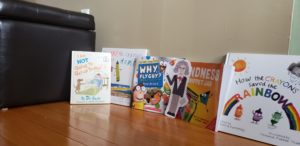Activities

Make your own instrument
Do you drive your teachers crazy at school by drumming on the desk with your pencils? Have you ever wanted to be a drummer or a musician? If so, this activity is for you.
WHAT YOU NEED
- An adult to help
- Different lengths of PVC pipes
- Two boards
- String
- A mallet or small hammer
WHAT YOU DO
- Create a xylophone by cutting PVC pipe into various lengths.
- Place them side by side on a frame from the longest to shortest.
- Cut two boards the appropriate length to accommodate all the pipes. These boards will make a good supporting frame. The best sound will be achieved by allowing a little less than a third of each pipe to extend off the frame. When you have the pipes the way that you want, tie them on the frame with string.
- You can tune your xylophone by cutting the pipes shorter for higher notes and leaving the pipes longer for the lower ones.
- Play the xylophone by striking the pipes with a mallet of some kind.
Have you ever wanted to play the violin or some other string instrument? In this activity, you can make your very own string instrument using ordinary household items!
WHAT YOU NEED
- Information about the instruments in the string family, found here.
- Wire clothes hanger
- Two pieces of string, each a few feet long
WHAT YOU DO
- Read about string instruments, particularly how they are built and how they produce sound.
- Make a string instrument using a wire clothes hanger and two lengths of nylon string. Tie two ends of one string across the bottom part of the hanger (like in the picture). Tighten it until the bottom wire bends up out of the way and tie it off so that it stays tight with your hand and then “play” it by plucking it.
- Take a second length of string about three feet long and tie one of it to something solid. Pull the other end tight with your hand and then “play” it by plucking it.
- Use your clothes hanger “bow” that you made and pull it across the string. Help students note that the tighter the string is, the higher the note will be.
Students will gain an understanding of how shaken percussion instruments sound by creating a simple set of maracas.
RESOURCES
- Meet the Percussion Family of Instruments
- 2 small plastic water bottles or 2 empty soda cans (rinsed and dried)
- Small dry objects such as seeds, uncooked rice, pasta, or dried beans
- Masking or packing tape
TEACHING SEQUENCE
- Provide each student with a copy of Meet the Percussion Family of Instruments.
- have students read about percussion instruments, particularly the maracas.
- Discuss with students how maracas produce sound.
- Have students partially fill their cans of bottles with the small dry objects.
- using the tape, students should close off the top of their cans or bottles, then (optional) decorate their “maracas.”
CULMINATING ACTIVITY
Have students take turns shaking their instruments, and ask them to compare the sounds of the different materials used.
EVALUATION
Do students demonstrate an understanding of how shaken percussion instruments produce sound?
CO-CURRICULAR CONNECTIONS/TEKS
Fine Arts – Music
Science
Do you like to measure things? In this activity, you will use brass instruments to measure everyday items. Sounds strange doesn’t it?
The first brass instrument that we know about is a trumpet found in a drawing in King Tutankhamen’s tomb in Egypt dating to 1500 B.C. – over three thousand years ago. The Egyptian trumpet was a long, straight tube made of silver or bronze, and was four feet long. This instrument could produce only a few tones. As the trumpet evolved (evolved – developed gradually over time), it became longer and was coiled to make the instrument easier to hold. Later, valves and tubing were added to let the players play all of the notes in the scale.
WHAT YOU NEED
- Pictures of the trumpet, trombone, French horn, and tuba
- A yardstick or ruler
WHAT YOU DO
- Look at pictures of the trumpet, trombone, French horn and tuba. How long do you think each instrument would be when unrolled or uncoiled?
- Do you see any connection in the length of each instrument to the sound of each instrument? The longer the tubing of each brass instrument, the lower the sound of the instrument. Therefore, the trumpet plays higher pitches or sounds than the tuba.
- Now using the copy of the” Brass instruments Uncoiled Chart” that you printed off, can you figure out how many trumpet lengths make up your kitchen table or a desk in your home. For example, my dinner table is two trumpets long. (My dinner table is 12 ft. long.) What about your bed? How many trombones does it take to walk from your room to the kitchen? What about your backyard or driveway? How many French horns would it take to go from your house to school? What other items or distances can you measure sing brass instruments?
SOMETHING ELSE
Have you ever tried to play a brass instrument before? Try “Buzzing Brass Mouthpiece” to find out how to make your own mouthpiece like the ones brass players use, and learn how to use it.
Students will gain an understanding of how drums produce sound by building and playing a simple drum.
RESOURCES
- Large empty coffee can
- Piece of heavy plastic trash bag
- Ruler
- Marker of chalk
- Scissors
- Large rubber band
- Spoon or pencil
TEACHING SEQUENCE
- Have students read the material.
- Discuss with students how a drum is constructed and how it produces sound.
- Have students measure the diameter of their can, then mark a circle two inches larger in diameter on their piece of plastic with the marker or chalk.
- Students then should cut out the circle of plastic and stretch it tightly over the top of the can, securing it with the rubber band.
CULMINATING ACTIVITY
Ask students to play their drums using the spoon, pencil or their hands to strike the top of the drum.
EVALUATION
Do students demonstrate an understanding of how drums produce sound?
CO-CURRICULAR CONNECTIONS/TEKS
Fine Arts – Music
Mathematics
Science
Do you like to annoy those around you by making funny sounds? Have you ever thought of playing a brass instrument? If so, this activity is for you.
Brass players play their instruments by blowing air between their closed lips causing them to vibrate together into their mouthpiece. When the lips vibrate in this way, it is called “buzzing.” This “buzzing” sound is the basic sound for all brass instruments. Practice buzzing your lips.
WHAT YOU NEED
- Bottles of various sizes
- An adult to help
WHAT YOU DO
- Make a mouthpiece by cutting the top off a plastic coke bottle (Be sure to leave enough of the bottle so that it flares out, making a place for you to buzz into.)
- Then create a “brass” instrument by inverting it into the top of a larger bottle or jug. Experiment with putting your mouthpiece into various jugs and containers to see what kind of sound is produced.
SOMETHING ELSE
Did you know that when you buzz your lips, you are making them vibrate? All sounds are produced by vibration.
How much do you know about the instruments in the brass family? To find out more about the brass instruments, click on the following links: trumpet, trombone, French horn, tuba.
Have you ever blown across the top of a soda bottle and heard the sound it makes? Here is another type of woodwind instrument you can make.
WHAT YOU NEED
- Plastic bottles and jugs of various sizes
- A small comb
- Paper squares approximately 2 inches by 2 inches
WHAT YOU DO
- Make a “woodwind” instrument by blowing across the top of a bottle. Experiment with various sizes of bottles and you will discover that larger bottles make a lower sound than smaller bottles when you blow across them.
- Make a reed instrument using a piece of paper and a comb. Hold a small pocket comb with the teeth pointed toward you. Place a small piece of paper on the comb on the side closest to you, holding it in place with your thumbs. By holding the comb and piece of paper together with your lips and blowing, you can make the paper vibrate which makes a sound.
Do you get in trouble for spending too much time talking to friends on the telephone? Here is a fun way to find out how sound travels and talk to friends at the same time.
WHAT YOU NEED
- An adult to help
- Two metal cans, clean and dry (Be sure that there are no sharp edges)
- Ten to Twelve feet of a piece of small diameter string such as kite string or nylon string
WHAT YOU DO
- Make a ‘Tin Can Telephone’ by punching a small hole in the bottom of each can. Each hole should be just large enough so that the string will go through.
- From the outside, insert one end of the string into the hole in one can. Tie a couple of knots in the end of the string so that it will not slip back through when pulled tight. Do the same with the other end of the string using the other can.
- With one person holding each can, stretch the string so that it is tight. Then have one person talk into one can while the other one listens on the other can. Then switch roles.
WHY IT WORKS
When someone speaks or makes a sound, the air ripples or vibrates. The word ‘vibrate’ means to move up and down, or back and forth rapidly. Our ears collect the sound vibration, or sound waves and send them to our brains. Then we hear the sound.
When you pull the string tight and talk into one of the cans of your tin can telephone, the sound vibrates across the taut string to the other can. The person at the other end of the telephone hears your message after his or her ears collect the sound vibrations and send them to the brain to be processed.
Students will gain understanding of how the size of an instrument affects the pitch of the sounds produced by the instrument.
RESOURCES
- 20 Clay flower pots, in a variety of sizes
- 5 wooden dowel rods approximately 18 inches in length
- String or cord, scissors, tape measure, and wooden spoon
TEACHING SEQUENCE
- Have students read about percussion instruments, particularly the chimes.
- Discuss how the size of each chime affects its pitch (high or low sounds).
- Divide students into 5 groups, giving each group 4 different size flower pots.
- Have each group of student cut four lengths of string: 30 inches, 24 inches, 18 inches, and 12 inches.
- Have students match pots and string from largest/longest to smallest/shortest.
- They should then put one end of the string through the hole in the pot and knot the string inside the pot so the pot hangs upside down from the string.
- Next, have them tie the free end of the string around the wooden dowel rod with the pots arranged from largest to smallest, left to right.
- One student should hold the rod so the pots hang freely while another student strikes the pots gently with the wooden spoon to produce sound.
Note: Steps 4 and 5 are only for visual reinforcement of tone differences, and are optional. Strings may be of equal lengths.
CULMINATING ACTIVITY
Ask the students to describe how the difference in the size of the pots affects the pitch of the sound they produce.
EVALUATION
Do students demonstrate an understanding of how the size of an instrument affects the pitch of its sound?
CO-CURRICULAR CONNECTIONS/TEKS
Fine Arts – Music
Science
DSO Kids Club

Join a fun and exciting club just for kids who love music and learning as much as you do. DSO Kids Club members receive periodic emails from the Dallas Symphony Orchestra full of music puzzles, information about upcoming Dallas Symphony events, what’s new on DSOKids.com, answers to your questions, and much more!
Sign up now
DSO Concert Coloring Book
Download Music in the Air, a dual language souvenir coloring book of a child’s trip to see the Dallas Symphony Orchestra.
Flat Beethoven

Connect your child, student, or classroom with the DSO by placing Flat Beethoven in different places and situations. Cut out Flat Beethoven along the dotted lines and start taking pictures of him in a new environment.
Send photos to s.hatler@dalsym.com, and please share any anecdotes or stories about Flat Beethoven’s adventures! This could be a great writing and/or music project for students.
We look forward to seeing and hearing where Beethoven goes!
PLEASE NOTE: Selected photos may be posted on the DSO Kids website, so please let us know if you would prefer that your photo not be posted.
Download now





